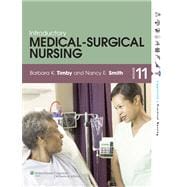This 11th Edition of Timby and Smith’s best-selling text equips LPN/LVN students with the practical knowledge and skills necessary to provide safe and effective nursing care to today's medical-surgical clients.
Acclaimed for its highly visual and easy-to-understand presentation, this edition prepares you to manage client nursing care in today's changing healthcare environments and eases the transition from classroom to clinical practice.
- Increase your understanding of the nursing process and its relationship to the client’s needs through new Nursing Concept Map visuals.
- See how the NCLEX-PN exam relates to chapter content through new Integrated NCLEX-PN questions that appear in each chapter.
- See how research relates to practice through Evidence-Based Practice boxes that include a Clinical Question, Evidence, and Nursing Implications.
- Fine tune your understanding of diseases, procedures, signs, symptoms, and normal vs. abnormal comparisons through dynamic visuals that replace text explanations when a picture better tells the story.
- Enhance your understanding of how pathophysiology, signs and symptoms, and nursing care differ for the older population through updated Gerontologic Considerations displays.
- Master the special considerations you need to remember when caring for clients who are receiving specific drugs through Pharmacologic Considerations displays.
- Handle the special nutritional needs of clients with certain types of conditions with Nutrition Notes displays.
- Increase your understanding of important physiological or pathophysiological concepts by viewing Concepts in Action Animations on thePoint website.
- Increase your recall and practical assimilation of concepts with each chapter’s Stop, Think, and Respond exercises.
- Develop a solid understanding of nursing care with more than 30 Nursing Care Plans (with rationales) that address such issues as Alzheimer's disease, cancer, myocardial infarction, stroke, diabetes mellitus, modified radical mastectomy, and chronic renal failure.
- Prepare for your future career with Nursing Process sections in each clinical chapter that emphasize a nursing process approach to care and provide rationales in italics for all interventions.
- Learn the major categories of drugs used for common conditions with the book’s Drug Therapy Tables that list examples of generic and trade names, mechanisms of action, common side effects, and nursing considerations.
- Learn to perform specific nursing skills and manage client care using the Nursing Guidelines.








